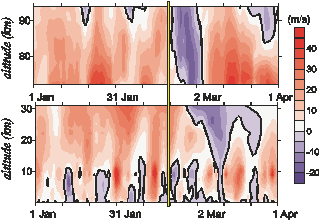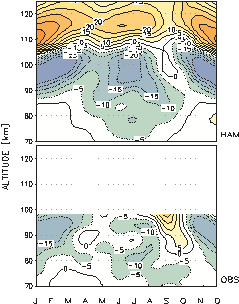|
Bridging the gap between the middle and upper atmosphere: coupling processes due to winds and waves over an extended altitude range
|
|
Dynamic coupling from the ground to the lower thermosphere (0 -120 km) is a crucial process in controlling the mean atmospheric circulation, with important consequences for the overall energy budgets of the atmosphere, climate change, etc. The dynamical coupling mainly involves forcing of mean winds by different atmospheric waves (tides, planetary waves and gravity waves), wind filtering of upward energy and momentum flux of atmospheric waves, and the interaction between different waves. While the impact of these dynamical processes on the mean circulation is believed to be the most important mechanism mediating atmospheric coupling, they are not well understood partly because the atmosphere at mesospheric and lower thermospheric altitudes (MLT region, 60 - 120 km) are difficult to observe. However, upward propagating waves generated in the troposphere and stratosphere show in the MLT region exponential increasing amplitudes due to the reduced air density and contribute to changes which by some orders of magnitudes stronger in contrast to changes in the troposphere. The project will use the extensive data sets collected during the International Polar Year (IPY). Particular attention is directed to the scientific use of the European Incoherent Scatter (EISCAT) radar data for furnishing neutral winds in the ionospheric E-region (100 – 120 km). Such a data set will provide an important upward extension of existing continuous wind observations by medium frequency (MF) and meteor radars (MR) in the MLT region at altitudes from 70 – 100 km (operating mainly over Northern Scandinavia).
The main scientific reasons to extend the study of neutral winds up to an altitude of about 120 km are: + Study of semi- and terdiurnal tidal waves over an extended altitude range. These waves have their maxima at altitudes above ~100 km, where they have the strongest influence on the background mean winds, (See Figure 1)
|
|
Joint studies of all available ground based observations with their excellent time resolution will be carried out in comparison with Incoherent Scatter Radar (ISR) observations over North America at Millstone Hill and Poker Flat and with observations on board of the TIMED satellite. The latter, though limited in their time resolution, will provide information about the global dynamical context. The interpretation of the observational diagnostics and the elucidation of the impact of the associated processes on the MLT will be provided by complementary modeling efforts. |
|
+ Investigation of vertical propagation of waves and their impact on the dynamical and thermal structure in the lower thermosphere. Of particular interest are coupling processes such as sudden stratospheric warming events during winter which significantly affect all atmospheric layers, (see Figure 2) |


|
|
Fig. 1 Semidiurnal tides in the meridional (South to North) wind [m/s] for mean monthly conditions for model output and observations at Andenes (16° E, 69° N).
HAM: HAMMONIA, general circulation model (Schmidt et al., 2006) 20-year averages,
OBS: MR and MF observations at Andenes, 2005. (Grieger, in preparation, 2008)
No measurements above 100 km so far! |
|
|
Fig. 2 Characteristic changes of zonal winds above Andenes (69°N, 16°E) during a SSW in winter 1998/99 (mesospheric data: Andenes MF radar; stratospheric data: ECMWF). The vertical line indicates the onset of the wind reversal in the mesosphere which occurs about one week before changes of the zonal circulation in the stratosphere start. (Hoffmann et al, 2007) |